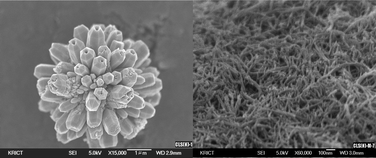We report here a new ternary chalcogenide material, cadmium lanthanum sulfide (CdLa2S4) produced using a facile hydrothermal method at 433 K. The effect of the solvent on the morphology of the CdLa2S4 was demonstrated for the first time. The prima facie observations revealed the formation of highly crystalline hexagonal structures in the form of flowers in aqueous medium. The flowers comprise hexagonal columns ∼300 nm in diameter and 1–1.2 μm in length. All the hexagonal structures have a sharp tip with a cavity of 10 nm and are almost equal in size. The nanoprisms have an average base size of 35 nm with 35 nm edges, and the nanowires have a diameter of 10–15 nm; both were obtained in methanol. Crystal and electronic structure calculations were performed using the Vienna ab initio simulation package (VASP) based on density functional theory (DFT). Considering the band gap of pristine CdLa2S4 in the visible region (2.3 eV), we have demonstrated CdLa2S4 as a photocatalyst for the production of H2 under solar light. Nanostructured CdLa2S4 prisms gave the maximum hydrogen production, i.e. 2552 μmol h−1. Being a stable ternary nanostructured metal sulfide (with nanohexagons, nanoprisms, nanowires), CdLa2S4 may have other potential prospective applications in solar cells and optoelectronic devices.

You have access to this article
 Please wait while we load your content...
Something went wrong. Try again?
Please wait while we load your content...
Something went wrong. Try again?


 Please wait while we load your content...
Please wait while we load your content...